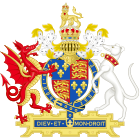Second Succession Act facts for kids

|
|
| Long title | An Act for the Establishment of the Succession of the Imperial Crown of this Realm. |
|---|---|
| Citation | 28 Hen. 8. c. 7 |
| Territorial extent | Kingdom of England |
| Dates | |
| Royal assent | June 1536 |
| Repealed | July 1543 |
| Other legislation | |
| Repeals/revokes |
|
| Repealed by | Statute Law Revision Act 1948 |
| Relates to | Succession to the Crown Act 1543 |
|
Status: Repealed
|
|
The Second Succession Act was an important law passed in England in June 1536. It was made by the Parliament of England during the time of Henry VIII, a famous king. This act changed who could become the next ruler of England.
Contents
What Was the Second Succession Act?
This law had a long official name: An Act concerning the Succession of the Crown. It was also known as the Succession to the Crown: Marriage Act 1536. This act was created after a big event: the end of King Henry VIII's marriage to Anne Boleyn.
Why Was This Act Needed?
King Henry VIII wanted a son to take over the throne after him. He had two daughters, Mary (with his first wife, Catherine of Aragon) and Elizabeth I (with Anne Boleyn).
The First Succession Act had already said that Mary could not inherit the throne. This new Second Succession Act went even further. It said that both Mary and Elizabeth could not become queen. This meant King Henry VIII had no official children who could inherit the throne at that time.
Who Could Be the Next Ruler?
Since Henry VIII had no official heir, the Second Succession Act gave him special power. It allowed him to choose who would become king or queen after him. He could do this by writing it down in a special document or in his last will. This was a very unusual power for a king to have.
Rules About the Throne
The Act also made it a very serious crime, called high treason, to go against these new rules. For example, it was treason if someone tried to stop the person Henry chose from becoming ruler. It was also treason to say that Henry's first two marriages were valid, or that his third marriage to Jane Seymour was not valid. Saying that Mary or Elizabeth were legitimate heirs was also treason.
Taking an Oath
Many people in England had to take an oath (a serious promise) to support this new law. If someone refused to take the oath, they could be charged with treason. People accused of treason under this act could not seek sanctuary, which was a way to find protection in churches. If found guilty, they could lose their own claim to the throne, if they had one.
When Did the Act Change?
The Second Succession Act was replaced a few years later in 1543. The new law, called the Third Succession Act, put Henry's daughters, Mary and Elizabeth, back in the line to the throne. However, it still did not say they were legitimate.
See also

